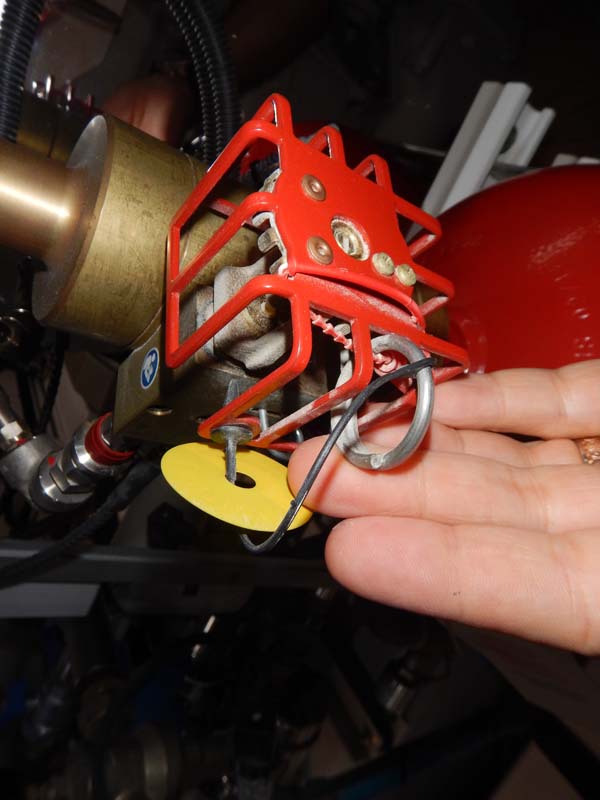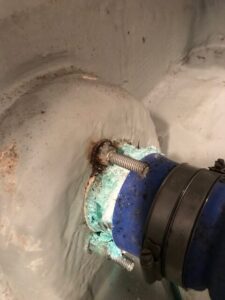Text and photos © 2021 Steve D’Antonio Marine Consulting, Inc.
Photo Essay: Fixed Fire Extinguisher Detail
Fixed fire extinguishers perform, or are ready to perform, an invaluable service to every vessel in which they are installed. In the event of an engine room fire, these units will discharge automatically, most at 175° Fahrenheit, as well as manually if equipped with a manual discharge cable and handle kit. This kit is an option on many but not all units. If you are contemplating installation, replacement or new construction, be certain to include the manual discharge option.
Many manual systems that include manual discharge capability also include a shipping or service pin, a component that is designed to be inserted while the bottle is being installed or removed, or the when the system is otherwise being worked on, to prevent accidental discharge, and herein lies the problem.
On many of the vessels I inspect, this pin has never been removed since it was installed at the facility where the bottle was manufactured. Vessel commissioning personnel usually have so much trepidation about touching these units, for fear of setting them off, that they never get close enough to read the instructions attached to the pin, calling for its removal after the bottle is installed.
Rest assured, the pin should be removed after the bottle is installed; although automatic discharge is not affected, until the pin is removed the bottle cannot be discharged manually. The manual discharge handle, located outside the protected space, has its own safety pin that must be removed before the bottle can be discharged, making accidental discharge almost impossible after the bottle has been installed.
In the accompanying image, the service pin has not been removed, making manual discharge of this bottle impossible. Check your bottle to make sure this pin has been removed.
Ask Steve
Steve,
I would like your opinion on an aluminum mast that either needs to be repainted or have the paint removed… is one method recommended over the other? Further, what is involved in paint removal?
This is on a Manta 42’ catamaran.
Kind Regards,
Bob Allen
Robert:
Stock spars that are not painted are smooth finished and typically anodized. The latter (anodizing), isn’t an option for an after the fact spar refit.
Stripping a painted aluminum mast isn’t terribly difficult, it can be done by professionals with blasting media (the existing paint type and thickness will determine which media is best). That should leave behind a uniformly dull, matt finish which is usually well suited for painting. If you want to leave it as is, uncoated, it shouldn’t be too rough, so again the blast media may determine this initially; it will then likely require a follow up dual action sanding and then polishing, which can be labor intensive. It needs to be smooth to prevent damage to sails and lines.
Stripping a painted mast and not re-painting it is unusual, because of the follow-up finishing required, however, there’s no good reason not to do it unless aesthetics are very important. Ideally, from a corrosion perspective, aluminum is best unpainted. For more on that subject see this article. An unfinished, non-anodized mast will become slightly rough or “dusty” over time, any bare aluminum would when exposed to the elements. Again, this is not harmful.
Above the waterline, paint over aluminum is strictly a cosmetic decision, and one that’s not without its technical challenges. Painting an aluminum spar, or any aluminum structure, requires careful attention to detail, and a thorough understanding of two part paint preparation and application technique. For more on the subject of painting aluminum see this article.
Dear Steve,
I am restoring an aluminum Colvin designed schooner and have a question regarding treatment of the shaft log to prevent corrosion.
I have sandblasted the hull, epoxied and antifouled below the waterline and plan to leave the topsides bare. The deck will be white (even the buff is hot on the feet) oil with sand for antiskid. But the shaft log is the question. My first inclination was to flap wheel bright and barrier coat with epoxy like the underbody, or even insert with epoxy a fiberglass liner- the log is inch and a half pipe and inch and a quarter slides in nicely, perhaps schedule 10? But if breach to the epoxy were to happen crevasse corrosion would certainly be a problem behind the pipe- the seal at the bottom by the cutlass bearing probably being the culprit, and a breach in the paint might show accelerated deep pitting (as is often seen in aluminum water tanks that are treated. So, as of yet, I am tending to think it might be best to leave the inside of the shaft log unpainted.
The shaft is electrically isolated from the engine through a phenolic coupling and the center bearing is isolated from the hull also. The log is about three feet long and will have both a composite cutlass and probably a Duramax composite drip less seal. I could weld a stub to the log for a pencil zinc (I suppose). There are 3 inch by 12 inch by 1 1/2 inch zincs welded to the outside of the keel each side in the proximity.
What are your thoughts regarding treatment of the inside of the shaft log on an aluminum hull?
Thanks,
Conrad Grillo
Conrad:
It’s clear that you have given this subject careful thought. Regrettably, I’m not certain there is one clear correct answer.
Leaving the log uncoated is tempting in that it avoids the breached coating issue. However, in order for aluminum to remain corrosion-free (aluminum, by the way, suffers from poultice rather than crevice corrosion, the latter is peculiar to stainless steel), it must have access to oxygen, and shaft logs are notoriously stagnant water environments, which is why disused propeller shafts often suffer from crevice corrosion.
On the other hand, preparing the inside of a shaft log for a coating will be very difficult, as will inspecting and maintaining that coating.
The shaft logs of most alloy vessels I encounter are uncoated. It’s difficult to know if this is by design or default, however, failures are relatively rare where cathodic protection is properly designed and maintained. In theory hull anodes will protect the log, however, it borders on being a ‘different body of water’, much like the engine, which requires its own anodes, and as such, an anode closer to the log, or inside, would be beneficial. Once complete, I’d recommend confirming proper protection using a reference electrode.
You might find this article on aluminum corrosion useful.
Hello Steve,
I always look forward to your articles and for the experience and knowledge.
I am curious about your preference for mineral spirits as a cleaning solvent. Although I use mineral spirits for the general cleaning of parts and because low volatility , but I also prefer acetone, lacquer thinner, and others depending on the particular job. I understand that some solvents have an adverse effect on certain materials.
All the best,
Jim Holley
Jim:
For surface prep and clean-up, I prefer mineral spirits over acetone, lacquer thinner and denatured alcohol for a few reasons. By comparison, mineral spirits is more benign than other solvents, it has less odor/fumes, it’s less volatile and it’s less likely to damage surrounding surfaces including paint, varnish and plastic. Having absented mindedly placed an acetone-soaked rag on a painted surface, I’m painfully aware of the potential for damage. In some cases sealant and plastic manufacturers specifically prohibit the use of certain solvents, although mineral spirits is rarely among them.
Always consult sealant manufacturer instructions to determine the preferred solvent for clean-up; as the article stated many preclude the use of alcohol.
Dear Steve,
My friend Lee Anderson and I have an identical situation, shown in the photograph below. Lee’s boat is a 2005 twin screw Mainship 34 and mine is a 2004 single screw Mainship 30. I have had this corrosion (?) for several years and Lee noticed his for the first time several months ago.
The green ground wire to this part is clean and securely attached to one of the 3 bolts holding the part in place in the shaft log. Zincs on the prop shaft, trim tabs and main zinc on the transom (to which all green wires terminate) are doing their job and are replaced each year. The raw water strainer for engine cooling and the smaller strainer for the A/C have a similar greenish tinge to the surface but no fuzzy material that can be removed. Both strainers have green grounding wires.
When you clean the area shown in the photo with a brass brush the outer fuzzy layer comes off easily but leaves a greenish patina on the fitting’s surface. In a week or two the fuzzy layer re-appears and the process of removal repeats itself. The fitting itself seems to be solid but looks can be deceiving. Can you diagnose the cause of the problem and recommend ways to keep it from happening? Thank you in advance for any help you can offer.
Sincerely,
Bernie Freeman
Bernie and Lee:
The phenomenon you are experiencing is common, it occurs to virtually every copper-based alloy used in marine (and other) applications; the best-known example is bronze deck hardware such as ports and cleats, as well as the Statue of Liberty, copper roofs and many others. Known as verdigris, or cuprous oxide, it’s both normal and harmless. Based on your photo, unless the appearance is bothersome to you, it should be of little concern. If, however, you ever see pink associated with underwater or raw water copper alloys such as bronze, that is of concern as it’s an indication of another type of corrosion called dezincification, you can read more about it here.
A far greater concern is the rust emanating from beneath the stainless steel through bolt. Stainless steel is a less than ideal material for use in below the waterline applications such as this. Fasteners are especially problematic since most off the shelf varieties are made from 18-8 alloy, the least corrosion-resistant of those suited for marine applications (for stainless steel, 316 is preferred). Used inside the vessel they are fine, however, they can be problematic on deck where they are prone to staining, and they should definitely not be used for submerged applications such as this. Silicon, zinc-free bronze is a far better choice for this fastening role. For more on this subject see this article.




